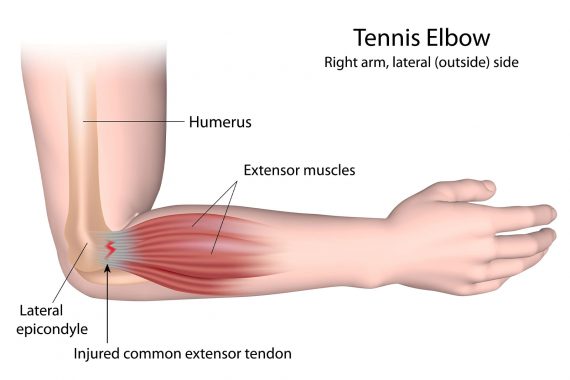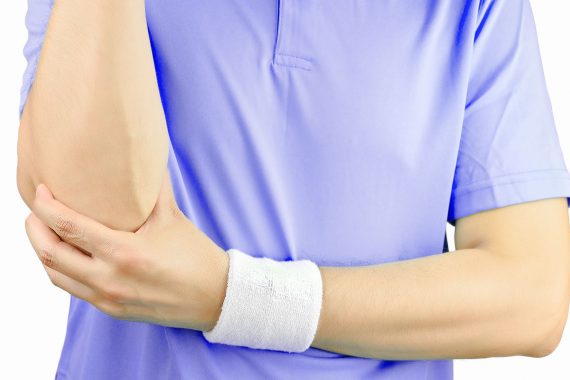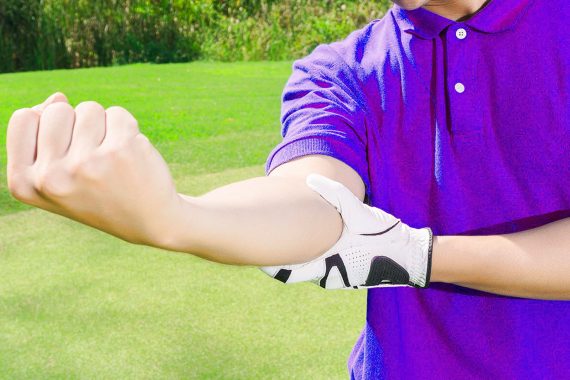Lateral Epicondylitis

Lateral Epicondylitis (Tennis Player’s Elbow), Medial Epicondylitis (Golfer's Elbow)
Lateral epicondylitis is commonly known as “Tennis Player’s Elbow”. It is a painful condition seen at the attachment of the muscle-tendon to the bone on the outside of the elbow as one of the tennis elbow symptoms. Tendons connect muscle to bone. The muscle associated with this condition is the “extensor carpi radialis brevis”. As a result, tennis elbow symptoms form.
In Tennis Player’s Elbow, there is degeneration and weakening of the tendon attachment section. This can cause pain associated with movements in which the muscle is active (stretching, grip, etc.). Medial epicondylitis, as known as “Golfer’s Elbow”, is a disease characterized by pain and sensitivity in the bony protrusion of the inside of the elbow.

How Is The Lateral Epicondylitis Diagnosed?
It is usually easy to diagnose. Methods such as film and MR are not required initially. However, if there is no improvement despite 6 weeks of treatment, a 2-way film of the elbow can be taken for differential diagnosis.
Eventually, ultrasound or MRI can be performed to find out whether there are other intra-articular or joint disorders.

Treatment Of The Lateral Epicondylitis
- Cold therapy should be the first intervention when elbow pain is felt.
- Use of anti-inflammatory drugs (aspirin, ibuprofen, naproxen and cream-based topical anti-inflammatories)
- Special elbow straps and physical therapy
- Mesotherapy
- P.R.P.
- Pulsed ultrasonic sound wave ESWT applications (exercises with the application head of the stone crushing device to the muscle tissue) can be applied in 3-5 sessions. Laser (HILTERAPY) with high intensity is another method that can be applied.
Tennis Elbow Symptoms and Treatment
The pain around the elbow is the most common of tennis elbow symptoms. Its medical name is lateral epicondylitis. Due to overuse of forearm muscles, patients experience pain around the elbow. As a result, it starts on the elbow and spreads through the forearm. Thus, people experience pain while bending or lifting their arm, holding some objects and opening the door besides having difficulty to extend their arm.
Causes of Tennis Elbow
Firstly, overusing elbow muscles that straighten the wrist causes tennis elbow symptoms. When we force our elbow muscles, inflammation, and tears can develop on the lateral epicondyle. Even if it is most common among tennis player because of repeated actions, any other repeated and tightening movement of the elbow joint can lead to lateral epicondylitis. On the other hand, the opposite side’s pain (inner elbow pain) is called golfer’s elbow.

When to See a Physical Therapist Related to Tennis Elbow Symptoms
Patients should see a physical therapist if the pain does not fade away in a week. Eventually, the physical therapist will examine your tennis elbow symptoms, wrist, elbow, and finger movements. On the other hand, more tests will be necessary like MRI or ultrasound scan if there is a suspicion about nerve damage.
Tennis Elbow Treatment in MedWorld Clinic, Antalya, Turkey
Even if tennis elbow can recover itself in time by resting your arm, there are some tennis elbow treatments that may be helpful to recover fast. Firstly, anybody that have tennis elbow should limit his or her arm’s movements. Also, ice compression helps to relieve the pain. Moreover, taking ibuprofen helps and paracetamol can relieve the pain if there is an inflammation as well. Furthermore, physical therapy is beneficial to regain mobility and relax muscle stiffness. If your physical therapist diagnoses a damage tendon, that means it may be more serious and surgical operation may be necessary.
Nevertheless, surgery must be the last choice. For this reason, physical therapists use a lot of conventional methods for tennis elbow treatments like manipulation and massage before surgery, which increase blood flow, causing to recover fast. Also, they help their patients to strengthen their muscles and regain their mobility. In addition to these, you can use bandages to support your wrist and elbow. 90 percent of tennis elbow cases fully recover in a year. Nonetheless, tennis elbow symptoms may go away in 5 months or more than a year.
Using steroid injections for tennis elbow treatment
Physical therapists sometimes advise their patients steroid injections if other treatments do not work. Yet, they have short term effects, so patients can only have 3 injections in 6 or 9 months. As a result, these injections are applied around the elbow.
Plasmolifting injections for tennis elbow treatment
Blood plasma, which is thrombocyte, helps new cell generation, which helps to repair damaged tendon in your elbow. Hence, your own blood is used to get thrombocyte and get rid of tennis elbow symptoms.
Shockwave therapy for tennis elbow treatment
What’s more, shockwaves are given to the painful area to enhance mobility. However, this method has not been proven yet. In addition, it has increased pain in some cases besides bruises on the skin.
Self-care for tennis elbow treatment
Furthermore, you can benefit from these advises below to avoid:
- Detect the repetitive action that cause tennis elbow and stop doing it, or you should find another way to do it.
- Get advice from health experts and professional to change your technique that does not harm your elbow.
- Sports players or people doing exercises regularly should not forget to do stretching and warm up exercises.
- Use your arm muscles equally, do not just put pressure on your wrist or elbow.
- practice with lighter equipments not to put extra pressure on your muscles.
- Wear elbow protector.
- Seek for advice from a physiotherapist to strengthen your forearm muscles.
How to Avoid Tennis
If you are a tennis player or if you have to overuse your elbow muscle, avoiding tennis elbow symptoms may not be easy. You must not force your elbow muscles much. It may be difficult for tennis players, but they can deal with the problem by changing their playing technique.
Activities that lead to tennis elbow symptoms
- Sports played with a racquet such as badminton, tennis, and squash.
- Throwing discus and javelin
- Works done with hand tools such as scissors and screwdriver and require repeated actions
- Some jobs such as plumbing, stonework, decorating
- Repetitive wrist and hand movements
- bending the elbow too long.
On the other hand, you do not need to worry because only 5 percent of tennis players experience tennis elbow symptoms.
